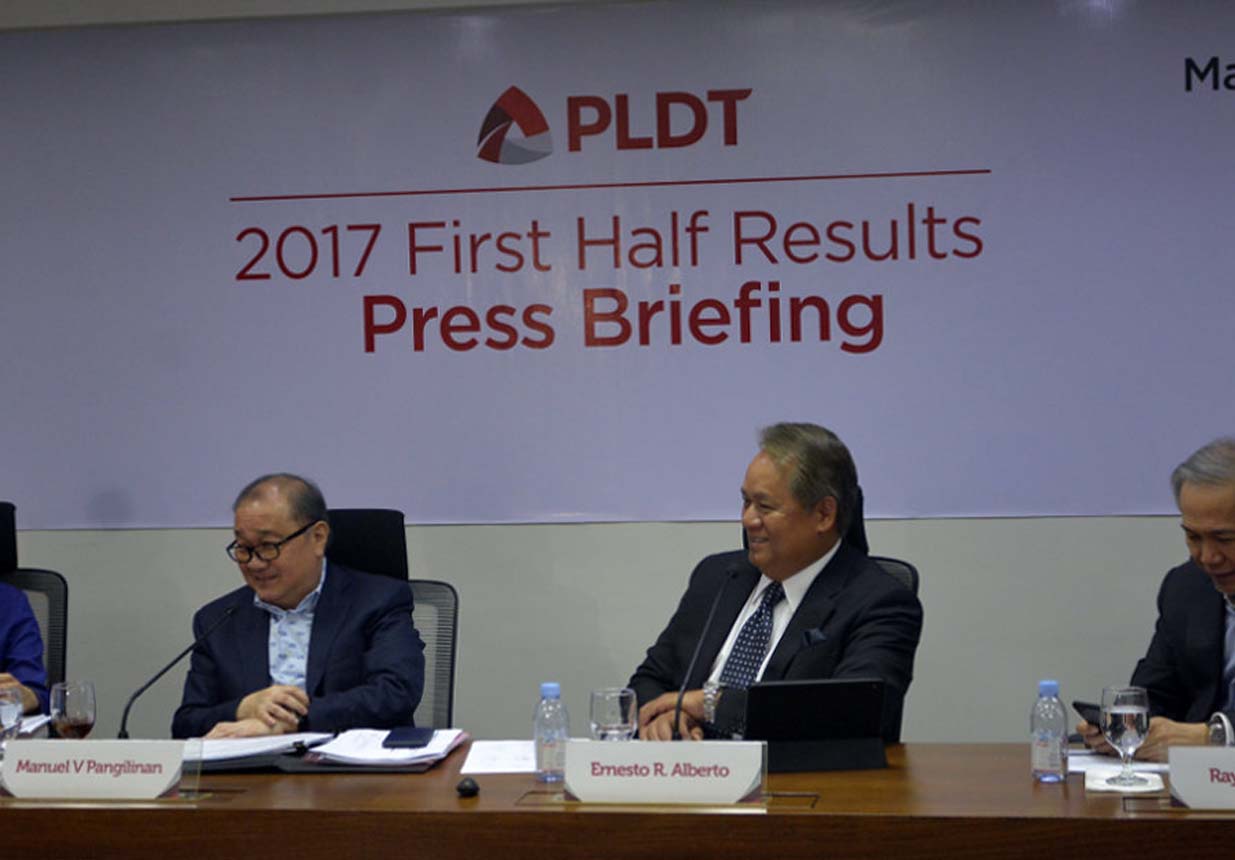
PLDT Inc. (“PLDT”) (PSE: TEL) (NYSE: PHI) today announced its unaudited financial and operating results for the first half of 2017 with Consolidated Service Revenues (net of interconnection costs) at Php71.2 billion. Though 6% lower year on year, service revenues for the first semester indicated that the downward trend of the topline for the past 6 quarters had been arrested, with second quarter service revenues levelling off and equaling those of the first quarter at Php35.6 billion. Similarly, quarter on quarter comparisons of other indicators provide further signs that the overall business is stabilizing.

In terms of business units, PLDT Home and Enterprise continued to set the pace for service revenues, posting double-digit growth rates in the first half of 2017. Home revenues grew 12% to Php15.8 billion, while Enterprise revenues increased 11% to Php16.8 billion. Home and Enterprise combined accounted for 46% of consolidated service revenues, surpassing the contribution of Wireless Consumer business of Smart, TNT and Sun.
The Wireless Consumer Business posted Php29.6 billion in revenues – 16% lower than the first half of 2016. However, quarter on quarter, revenues in the 2nd quarter of this year rose 1% from the previous quarter, from Php14.7 billion to Php14.9 billion – the first time in eight quarters that Wireless Consumer revenues registered an upturn.
Consolidated EBITDA for the first half of 2017 reached Php32 billion, 4% higher than the same period last year and 5% higher than the second half 2016. This sequential improvement in EBITDA was due to rigorous expense management and reductions in subsidies and provisions amounting to Php4 billion. Excluding the Php1.5 billion in manpower reduction program (MRP) costs booked in the second quarter, EBITDA for the first half would be 9% higher than the same period in 2016.
EBITDA Margin stood at 42%, higher than the 38% recorded in last year’s first semester. Excluding MRP expenses, EBITDA Margin would be at 44%.
Consolidated Core Income in the first half of 2017 amounted to Php17.4 billion, 2% lower than last year’s figure but 72% higher than the second half of 2016. Excluding gains from assets sales, EBITDA adjustments (including MRP expenses) and related tax adjustments, recurring core income stood at Php11.9 billion, 1% higher year on year and in line with the full year guidance of Php21.5 billion.
Reported net income amounted to Php16.5 billion in the first half of 2017, 33% higher than last year and 119% higher than the second half of 2016. The large percentage increases stemmed from the significant impairment of PLDT’s investment in Rocket Internet which negatively impacted on reported net income last year.
The view is even more upbeat when taken quarter on quarter. Core income jumped 127% from Php5.3 billion in the first quarter of 2017 to Php12.1 billion in the second. Recurring core income is up 23% to Php6.6 billion, while reported net income climbed 134% to Php11.6 billion.
In line with PLDT’s dividend policy, the Board of Directors declared an Interim Regular Dividend of Php48 per share which will be paid on 8 September 2017 to shareholders on record as of 25 August 2017.
As of end-June 2017, Consolidated Net Debt amounted to US$2.6 billion while Net Debt to EBITDA was 2.1x, an improvement from 2.36x as of end-2016 due largely to the sale of PLDT’s remaining shares in Beacon Electric Asset Holdings Incorporated (Beacon). Gross debt totaled US$3.5 billion, of which 23% is US dollar-denominated following the peso refinancing of the 8.35% US$ bond which matured in March 2017. Only 9% of total debt is unhedged, taking into account available US dollar cash and hedges allocated for debt.
As of end-June 2017, PLDT investment grade ratings remain unchanged from year-end 2016.
“We’ve followed through on the initial gains in our efforts to stabilize the overall business of the Group by stanching the decline of the Wireless Consumer business and sustaining the strong growth of our Home and Enterprise businesses. While it is still early in the game, our focused, collaborative efforts, efficiently utilizing the resources of the entire Group to pursue clearly defined goals have produced encouraging results,” said Manuel V. Pangilinan, Chairman and CEO of PLDT and Smart Communications.
Data and Broadband are key growth drivers
Data, Broadband and Digital Platforms combined were the key growth drivers for all business groups — Home, Enterprise and Wireless Consumer. Net of interconnection costs, this cluster of service revenues grew 11% to Php32.6 billion and represented 46% of the total revenue mix. Mobile internet revenues climbed 18% to Php9.6 billion, Corporate data and data center revenues increased 15% to Php9.7 billion and Fixed home broadband revenues rose 19% to Php8.4 billion.
Data and broadband accounted for 63% of fixed line and 34% of wireless services revenues, up from 59% and 29%, respectively in the first half of 2016. Data and broadband revenues now comprise 62%, 65% and 38%, respectively, of Home, Enterprise and Wireless Consumer Business service revenues.
“Data usage is rising rapidly as our customers – whether individuals or companies – are increasingly adopting multiple digital services, including everything from video entertainment to corporate security solutions. To serve this growing need, we are utilizing our unmatched wired, wireless and digital infrastructure to give customers the best possible data experience,” said Ernesto R. Alberto, PLDT Group Chief Revenue Officer.
Wired and Wireless Network Roll-outs
In the first half of 2017, PLDT continued to roll-out of its fiber optic cable facilities to serve residences and offices in more areas of the country.
Under itsSmart Fibr Citiesprogram, PLDT expanded the reach of its fiber-to-the-home (FTTH) services in south Metro Manila and east Metro Manila, adding over 370,000 fiber links that can deliver world-class internet service to residences and offices.
Done in cooperation with the local governments of these areas, this expansion program covered cities such as Makati, Pasay, Paranaque, Muntinlupa and Las Pinas in the south, and, Antipolo, Marikina, Pasig, Taguig, Caloocan in the eastern areas of Metro Manila. Earlier, PLDT had set up Smart Fibr Cities in Toledo City, Cebu; General Santos City, South Cotabato and Naga City, Camarines Sur. As a result, the footprint of PLDT’s fiber network covered about 3.1 million homes passed as of end-June 2017, up from 2.8 million as of end- 2016.
The FTTH roll-out is being complemented by the deployment of hybrid fiber technologies like G.fast, which is used extensively in Germany and South Korea, to deliver fiber-like data speeds via copper lines in residences and offices. The initial target areas for G.fast are existing high-rise buildings that are wired up with copper and would be difficult to re-fit with internal fiber cabling.
Meantime, Smart is pursuing its three-year program to roll out LTE in 95% of the country’s cities and municipalities by end-2018. “As of end-July, we were about half-way through in north Metro Manila and close to completion in south Metro Manila and Metro Cebu,” said Mario G. Tamayo, PLDT and Smart Senior Vice President for Network Planning and Engineering.
Earlier, Smart had completed the deployment of new LTE facilities as well as additional 3G and 2G base stations in metro Davao and the resort island of Boracay.
Smart’s network enhancement program is already benefiting its customers through better LTE and 3G coverage, particularly indoors, and faster data speeds. Internal tests show that Smart’s LTE service is posting average download speeds ranging from about 21.5 Mbps in areas of north Metro Manila to around 14.4 Mbps in areas of south Metro Manila where new LTE base station facilities have already been installed.
These internal tests were corroborated by the results of the latest J.P. Morgan Asia Network Quality study which found that the availability of Smart’s LTE in Metro Manila had increased from 49% at the start of 2017 to 63% as of the July 2017 report. Citing crowd-sourced data gathered by wireless coverage research firm OpenSignal in the months April to June, the report said Smart had a “significant lead in LTE speeds” across all areas.
Smart continues to upgrade its network technologies. Last July, Smart, working with Huawei Technologies Philippines, successfully activated 4-component carrier (4CC) aggregation in Boracay, reaching average data speeds of 280 Mbps in initial runs using test software on Samsung’s latest flagship smartphones, the Galaxy S8 and Galaxy S8+, the first 4CC-capable handsets available in the market. Further tests have achieved speeds of up to 500 Mbps via 4x4 Multiple Input, Multiple Output (MIMO) and 256 Quadrature Amplitude Modulation (QAM) technology.
Side by side its LTE expansion program, Smart is rolling out its Smart WiFi service in hightraffic public places all over the country. In the second quarter of 2017, Smart participated in the EDSA Free Wi-Fi Project initiated by the Department of Information and Communications Technology (DICT) by installing carrier-grade WiFi coverage in thirteen stations of the MRT 3 in Metro Manila. It is also rolling out this service in the terminals of the LRT 1 rail system.
This is in line with Smart’s program to provide high-speed WiFi in transportation hubs. Since last year, Smart has equipped 28 major airports, 20 bus terminals and 11 seaports with carrier-grade WiFi. Smart is also bringing WiFi to schools, government buildings, hospitals, malls and entertainment centers. In the first half of 2017, Smart set up 18 “Smart Spots” – providing high-speed WiFi – to around 350 restaurants and other establishments in different parts of the country.
“Through these parallel roll-outs of our fixed and mobile networks, we aim to provide the public with various options to access high-quality data services wherever they may be – at home, at work, at play and on the go,” said Pangilinan said.
“With respect to our full year capex guidance, we expect to complete projects amounting to Php38 billion in 2017, with a balance of approximately Php15 billion that we forecast will be finished in 2018,” added Pangilinan.
Beyond solutions selling
With more powerful networks at hand, PLDT and Smart are offering richer data content and services.
In June, PLDT launched its Roku-powered TVolution box, an all-in-one, plug-and-play entertainment solution that delivers popular films from iflix and Netflix, as well as content from Cignal TV, YouTube and over 100 other video streaming channels.
“This breakthrough service gives PLDT Home Fibr customers easy access to a wide range of hit movie, TV and video streaming content via their web-linked TVs, with an easy-to-use remote control,” said PLDT First Vice President and Home Business head Oscar Enrico Reyes, Jr.
To amplify the WiFi signal of its Fibr service, PLDT also launched the Whole Home WiFi plan Router which extends wireless data coverage within residences.
The Wireless Consumer Group is stepping up efforts to bring the benefits of its muchimproved LTE service to more customers. Working with handset manufacturers MyPhone, Oppo, Samsung, Vivo and Starmobile, it launched campaigns to encourage Smart, TNT and Sun customers to shift to LTE handsets, particularly those running on 700 Mhz and other LTE and 3G frequencies being used in the Smart network.
Early this year, TNT introduced LTE-enabled SIMs, opening the door to high-speed data to TNT subscribers. Starting August, LTE SIMs have also been made available to Sun customers as well.
Taking advantage of faster mobile data speeds, Smart has introduced new data packages offering video content with bundled subscriptions. Smart’s Video Prime 99 comes with a 2Gb data allocation and subscription to top streaming sites iflix and iWant TV valid for 7 days.
“As smartphone penetration rises, video viewing on-the-go is becoming a mass experience. That is the opportunity that our ongoing LTE roll out is opening up. Meeting the growing demand for mobile viewing is key to delighting our customers and monetizing our data services,” Alberto said.
For PLDT Enterprise, its clear leadership in digital infrastructure has powered its growth in recent years. This has enabled the Enterprise group to deliver to clients high-bandwidth, reliable, and secure connectivity augmented by the largest network of data centers in the country. This has become the bedrock of the digital transformation initiative of many enterprises.
This capability has enabled the group to partner with global companies in delivering digital and cloud solutions to the market. In the first half of 2017, for example, PLDT tied up with global IT leader Cisco to offer next-generation business solutions, starting with intelligent WiFi connectivity for large and small companies.
“For us to further solidify our undisputed leadership in the Enterprise business, we are aggressively pursuing our own transformation journey. This transformation does not only focus on technology. More importantly, we continue to retool and retrain our people so that we can build expertise and establish world class ICT practices. PLDT's quality leadership has won the confidence of enterprises – both large corporates and SME’s – who have entrusted to us their critical operations, making us integral partners in their efforts to execute their strategy and sustain their competitive advantage,” said Juan Victor Hernandez, Senior Vice President and Head of PLDT and Smart Enterprise.
Meanwhile, digital unit Voyager Innovations is also gaining breakthrough traction in its platforms and services for enterprises and consumers. PayMaya Philippines is leading the adoption of cashless ecosystems by local governments. Cities such as Muntinlupa, Balanga, Malolos, Catbalogan and Tacloban are now using PayMaya cards to disburse financial support and grants, and, to accept payments for services.
FINTQ, Voyager’s financial technology arm, launched a new commercial campaign for its digital loans marketplace Lendr in June and saw a more than twenty-fold increase in signups and loan applications in just one month. Lendr now counts on more than forty banks and financial institutions as its partners. Through Lendr, these partner institutions have disbursed more than Php21 billion of loans to more than 200,000 borrowers.
“We are moving on to a new stage of growth as our financial platforms and services become more pervasive and reach more people in the farthest corners of the country,” said Orlando B. Vea, President of Voyager Innovations, Inc.
Conclusion
“We have made steady progress in the first half of this year in stabilizing our overall business and positioning the Group to return to a growth path, largely on the back of data and broadband services. Our Home and Enterprise business units have led the way, in growing for at least six consecutive quarters already, because they have succeeded in executing their digital shift much earlier. We are now focused intently on doing the same for our Wireless Consumer business. The interim results have lent greater confidence in maintaining our guidance for Full Year Recurring Core Income (before exceptionals) at Php21.5 billion,” Pangilinan concluded.


